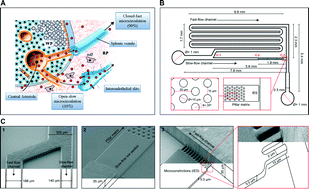A functional microengineered model of the human splenon-on-a-chip†
Abstract
The spleen is a secondary lymphoid organ specialized in the filtration of senescent, damaged, or infected red blood cells. This unique filtering capacity is largely due to blood microcirculation through filtration beds of the splenic red pulp in an open-slow microcirculation compartment where the hematocrit increases, facilitating the recognition and destruction of unhealthy red blood cells by specialized macrophages. Moreover, in sinusal spleens such as those of humans, blood in the open-slow microcirculation compartment has a unidirectional passage through interendothelial slits before reaching the venous system. This further physical constraint represents a second stringent test for erythrocytes ensuring elimination of those cells lacking deformability. With the aim of replicating the filtering function of the spleen on a chip, we have designed a novel microengineered device mimicking the hydrodynamic forces and the physical properties of the splenon, the minimal functional unit of the red pulp able to maintain filtering functions. In this biomimetic platform, we have evaluated the mechanical and physiological responses of the splenon using human red blood cells and malaria-infected cells. This novel device should facilitate future functional studies of the spleen in relation to malaria and other hematological disorders.


 Please wait while we load your content...
Please wait while we load your content...